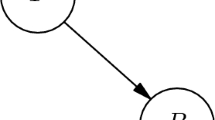Abstract
In the artificial intelligence literature a promising approach to counterfactual reasoning is to interpret counterfactual conditionals based on causal models. Different logics of such causal counterfactuals have been developed with respect to different classes of causal models. In this paper I characterize the class of causal models that are Lewisian in the sense that they validate the principles in Lewis’s well-known logic of counterfactuals. I then develop a system sound and complete with respect to this class. The resulting logic is the weakest logic of causal counterfactuals that respects Lewis’s principles, sits in between the logic developed by Galles and Pearl and the logic developed by Halpern, and stands to Galles and Pearl’s logic in the same fashion as Lewis’s stands to Stalnaker’s.
Similar content being viewed by others
Notes
As Lewis (1973, p. 3) noted, this slightly ungrammatical reading of φ \(\square\hskip-.35pc\rightarrow\) ψ (instead of if it had been the case that φ, it would have been the case that ψ) was deliberate, in order not to interfere with tense. Moreover, the antecedent is not required to be actually false, so some conditionals under the radar are, properly speaking, not contrary-to-fact conditionals. Like Lewis, I will tolerate this terminological inaptness.
This formulation assumes that there are closest φ-worlds, which Lewis labels the Limit Assumption (1973, pp. 19–20). Lewis’s semantics can be formulated without this assumption, but the present, slightly less general formulation fits our purposes well.
In Lewis’s language, there is no restriction on the form of antecedent, so Ant(L) is just the set of all sentences. But as we will see, the form of antecedent is restricted in the language of causal counterfactuals. In that language, Ant(L) is a proper subset of the set of all sentences.
Stalnaker’s (1968) own formulation is in terms of world-selection function instead of set-selection function, where an absurd world is included to play the role of the empty set.
The notation of [] (and 〈 〉 to be introduced later) is obviously borrowed from dynamic logic (e.g., Harel 1979).
It might be tempting to simply dismiss the problem, on the ground that counterfactuals with disjunctive antecedents concern consequences of interventions that are not well defined, and so should not bear truth values under the causal semantics. But some counterfactuals of this sort seem to have as determinate a truth value as any counterfactual can. Consider the firing squad example. Suppose, as it happened, the court decided not to order execution. As a result, neither rifleman shot, and the prisoner survived. The following counterfactual seems clearly true: if rifleman 1 had shot or rifleman 2 had shot, the prisoner would have died.
GP (as well as Halpern) also considered the class of recursive models, a subclass of M un(S). That class, though important for other purposes, does not need a special attention for the purpose of this paper.
Halpern (2000, p. 326) used a slightly different but equivalent expression in the first conjunct of this schema (his D9).
Halpern (2000, p. 326) seemed to remark in passing that the [] version of composition is also valid in his logic, which, if I understood his remark correctly, was a mistake.
References
Ellis, B., Jackson, F., & Pargetter, R. (1977). An objection to possible-world semantics for counterfactual logics. Journal of Philosophical Logic, 6, 355–357.
Fisher, F. M. (1970). A correspondence principle for simultaneous equation models. Econometrica, 38, 73–92.
Galles, D., & Pearl, J. (1998). An axiomatic characterization of causal counterfactuals. Foundation of Science, 3, 151–182.
Ginsberg, M. L. (1986). Counterfactuals. Artificial Intelligence, 30, 35–79.
Ginsberg, M. L., & Smith, D. E. (1987). Reasoning about action I: A possible worlds approach. In F. M. Brown (Ed.), The frame problem in artificial intelligence (pp. 233–258). Los Altos, CA: Morgan Kaufmann.
Halpern, J. Y. (2000). Axiomatizing causal reasoning. Journal of Artificial Intelligence Research, 12, 317–337.
Harel, D. (1979). First-order dynamic logic. Berlin & New York: Springer.
Hiddleston, E. (2005). A causal theory of counterfactuals. Noûs, 39, 632–657.
Hughes, G. E., & Cresswell, M. J. (1996). A new introduction to modal logic. London & New York: Routledge.
Lewis, D. (1973). Counterfactuals. Oxford: Blackwell.
Lewis, D. (1977). Possible-world semantics for counterfactual logics: A rejoinder. Journal of Philosophical Logic, 6, 359–363.
Pearl, J. (1995). Causal diagrams for empirical research. Biometrika, 82, 669–710.
Pearl, J. (1998). Graphs, causality, and structural equation models. Sociological Methods and Research, 27, 226–284.
Pearl, J. (2009). Causality: Models, reasoning, and inference (2nd ed.). Cambridge, UK: Cambridge University Press.
Spirtes, P., Glymour, G., & Scheines, R. (2000). Causation, prediction, and search (2nd ed.). Cambridge, MA: MIT Press.
Stalnaker, R. (1968). A theory of conditionals. In N. Rescher (Ed.), Studies in logical theory (pp. 98–112). Oxford: Blackwell.
Stalnaker, R., & Thomason, R. H. (1970). A semantic analysis of conditional logic. Theoria, 36, 23–42.
Strotz, R. H., & Wold, H. O. A. (1960). Recursive versus nonrecursive systems: An attempt at synthesis. Econometrica, 28, 417–427.
Winslett, M. (1988). Reasoning about action using a possible worlds approach. In Proceedings of the Seventh American Association of Artificial Intelligence Conference (pp. 89–93).
Woodward, J. (2003). Making things happen: A theory of causal explanation. Oxford & New York: Oxford University Press.
Woodward, J., & Hitchcock, C. (2003). Explanatory generalizations, part I: A counterfactual account. Noûs, 37, 1–24.
Acknowledgments
I thank Lam Wai Yin for helpful discussions on issues related to this article, and the audiences of a seminar at Carnegie Mellon University for useful feedback. My research was supported in part by the Research Grants Council of Hong Kong under the General Research Fund LU341910.
Author information
Authors and Affiliations
Corresponding author
Rights and permissions
About this article
Cite this article
Zhang, J. A Lewisian Logic of Causal Counterfactuals. Minds & Machines 23, 77–93 (2013). https://doi.org/10.1007/s11023-011-9261-z
Received:
Accepted:
Published:
Issue Date:
DOI: https://doi.org/10.1007/s11023-011-9261-z




